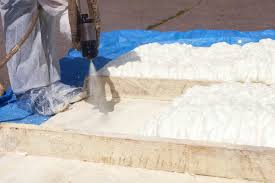
The Benefits of Polyurethane Foam Roofing
Polyurethane foam roofing is gaining popularity as a cost-effective and durable solution for commercial and industrial buildings. This innovative roofing material offers a range of benefits that make it a preferred choice for many property owners.
Energy Efficiency
One of the key advantages of polyurethane foam roofing is its excellent energy efficiency. The seamless application of the foam creates a continuous insulation layer that helps regulate indoor temperatures, reducing the need for heating and cooling. This can lead to significant energy savings over time.
Waterproofing Properties
Polyurethane foam roofing provides superior waterproofing properties, making it highly resistant to water infiltration. Its seamless and monolithic structure eliminates seams and joints where leaks can occur, offering enhanced protection against water damage.
Lightweight and Durable
Despite being lightweight, polyurethane foam roofing is incredibly durable and long-lasting. It can withstand harsh weather conditions, including high winds, hail, and UV exposure. Its flexibility allows it to expand and contract with the building structure without compromising its integrity.
Ease of Installation
The application process of polyurethane foam roofing is relatively quick and straightforward compared to traditional roofing materials. The foam can be sprayed directly onto the roof surface, conforming to any shape or contour. This results in minimal disruption during installation and reduced labor costs.
Environmental Sustainability
Polyurethane foam roofing is considered an environmentally friendly option due to its energy efficiency and longevity. Its reflective surface helps reduce heat absorption, lowering urban heat island effects. Additionally, the material can be recoated or repaired rather than replaced, extending its lifespan and reducing waste.
Conclusion
In conclusion, polyurethane foam roofing offers a multitude of benefits that make it an attractive choice for property owners looking for a reliable and sustainable roofing solution. With its energy efficiency, waterproofing properties, durability, ease of installation, and environmental sustainability, polyurethane foam roofing stands out as a versatile option for modern construction projects.
Understanding Polyurethane Foam Roofing: Lifespan, Drawbacks, Applications, and Definitions
- How long does a polyurethane foam roof last?
- What are the disadvantages of foam roofing?
- Can I use polyurethane on roof?
- What is a polyurethane foam roof?
How long does a polyurethane foam roof last?
Polyurethane foam roofs are known for their durability and longevity, with a typical lifespan ranging from 20 to 30 years or more when properly maintained. Factors such as climate conditions, maintenance practices, and the quality of installation can influence the longevity of a polyurethane foam roof. Regular inspections, timely repairs, and recoating can help extend the lifespan of the roof, ensuring that it continues to provide reliable protection for years to come.
What are the disadvantages of foam roofing?
While polyurethane foam roofing offers numerous advantages, there are some disadvantages to consider. One common concern is the initial cost of installation, as foam roofing may require a higher upfront investment compared to traditional roofing materials. Additionally, foam roofs can be susceptible to damage from foot traffic or punctures if not properly maintained. UV exposure can also cause the foam to degrade over time, leading to a decrease in its insulating properties. However, regular inspections and maintenance can help mitigate these issues and prolong the lifespan of a foam roof.
Can I use polyurethane on roof?
Polyurethane foam roofing is a popular choice for many property owners looking for a reliable and cost-effective roofing solution. Yes, polyurethane can be used on roofs as it offers excellent insulation properties, waterproofing capabilities, and durability. The seamless application of polyurethane foam creates a protective barrier that helps regulate indoor temperatures, prevents water infiltration, and withstands harsh weather conditions. Its lightweight nature and ease of installation make it a practical option for various roof types. Overall, using polyurethane foam on roofs can provide long-term benefits in terms of energy efficiency, protection against the elements, and overall sustainability.
What is a polyurethane foam roof?
A polyurethane foam roof is a type of roofing system that involves spraying a layer of polyurethane foam insulation directly onto the roof surface. This foam material expands and forms a seamless, monolithic membrane that provides excellent insulation and waterproofing properties. Polyurethane foam roofs are lightweight, durable, and energy-efficient, making them a popular choice for commercial and industrial buildings. The application process allows the foam to conform to any shape or contour, creating a continuous protective barrier that helps regulate indoor temperatures and reduce energy costs.
